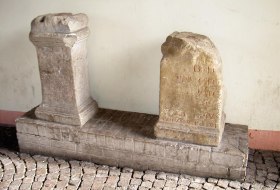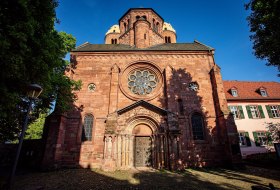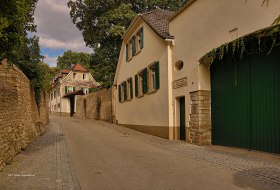
searchMenu


A roofed passage near Ballplatz features two altars that form part of a Mithraeum, a temple erected in classical Antiquity by the worshippers of Mithras. The cult of the Persian god of light was brought by soldiers to Mogontiacum during the 2nd century CE. We now know that the site around these consecration altars was the largest Mithraeum in the city.

In memory of the last "Ausscheller" in the municipality, a sculpture was erected in 2011, which is supposed to represent the former municipal servant and Ausscheller for public announcements - Mr. Karl Ritzinger. The work of art was made of black sheet metal by Gerd Vollmer and depicts the former parish clerk with the bell raised and the official announcements that he read out at various points in the parish.

The village church is composed of a Romanesque tower, a Gothic choir and a Baroque long house. The flat-roofed choir was built in the middle of the 15th century and equipped with extensive murals. On the left wall is a large protective mantle god. Saints are depicted between the four tracery windows. In the basement level, a circumferential carpet of rugs is painted, as a crowning of the figures a rich pseudo-architecture. Liebfrauenland - Gothic in Rheinhessen

HILDEGARD OF BINGEN ON RUPERTSBERG Hildegard of Bingen left her home abbey on Disibodenberg between 1147 and 1151 and founded her abbey on Rupertsberg, on the Nahe river. “This abbey was founded not by an emperor or bishop, a powerful or rich person of this world, but rather by a poor, weak, immigrant woman. Within a short time, after 27 years, it has grown both in monastic spirit and in external construction, such that it is well appointed in all aspects, not with ostentatious but rather with imposing and spacious buildings – such as befit…

The Untertorturm is one of the seven towers of the Fleckenmauer wall built in the 15th century for protection. The gate, which was knocked down in 1840, was previously operated day and night. The battlements led around the tower over the gate to the other side of the street. Until the renovation in 1989, the high entrance in the west was the only access to the three-storey watchtower. Among other things, the tower served as a guardroom and probably also as the guard's flat. Text according to the signs on the tower with the kind permission of…

The monastery and convent of St. Paulus, built from 1002 onwards, is located in the centre of Worms and is a place of peace and quiet in this lively city. The collegiate church was originally built as a three-nave Romanesque pillar basilica, and the stone dome helmets of the two pagan towers give the church its special appearance. Unlike other collegiate churches, the choir is closed on five sides in good late Romanesque forms. The west building has an octagonal dome (13th century) and is flanked by two older stone-covered round towers…

Non-historical replica of the 21st (penultimate) telegraph station, which was built in 1813 between Elsheim, Schwabenheim and Wackernheim to close the network of the then new telegraph between Metz and the then French city of Mainz. Reconstruction in 2016 and supported with LEADER funds. Contribution of the local community of Stadecken-Elsheim to the 200th anniversary of Rheinhessen. Text provided by the local community of Stadecken-Elsheim.

The lower part of Stiegelgasse and Edelgasse form one of the early cores of Ober-Ingelheim’s settlement. Here a significant number of aristocratic estates were concentrated. Most were singular farmsteads surrounded by large gardens or parks. The estate Stiegelgasse 65 with the Bodepark once belonged to the von Beuser family, one of the two sidelines of an early mentioned old Ingelheim kin of nobles. Around 1837, on this site, the estate of the wine and vinegar merchant Philipp August Gerhard was created, using old foundations. The…